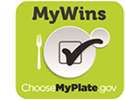NSU Newsroom
SharkBytes
Horizons
This version of NSU News has been archived as of February 28, 2019. To search through archived articles, visit nova.edu/search. To access the new version of NSU News, visit news.nova.edu.
This version of SharkBytes has been archived as of February 28, 2019. To search through archived articles, visit nova.edu/search. To access the new version of SharkBytes, visit sharkbytes.nova.edu.
10 Nutrition Tips
Source: Choose My Plate
 Use MyPlate to build your healthy eating style and maintain it for a lifetime. Choose foods and beverages from each MyPlate food group. Make sure your choices are limited in sodium, saturated fat, and added sugars. Start with small changes to make healthier choices you can enjoy.
Use MyPlate to build your healthy eating style and maintain it for a lifetime. Choose foods and beverages from each MyPlate food group. Make sure your choices are limited in sodium, saturated fat, and added sugars. Start with small changes to make healthier choices you can enjoy.
1. Find your healthy eating style
Creating a healthy style means regularly eating a variety of foods to get the nutrients and calories you need. MyPlate’s tips help you create your own healthy eating solutions—“MyWins.”
2. Make half your plate fruits and vegetables
Eating colorful fruits and vegetables is important because they provide vitamins and minerals and most are low in calories.
3. Focus on whole fruits
Choose whole fruits—fresh, frozen, dried, or canned in 100% juice. Enjoy fruit with meals, as snacks, or as a dessert.
4. Vary your veggies
Try adding fresh, frozen, or canned vegetables to salads, sides, and main dishes. Choose a variety of colorful vegetables prepared in healthful ways: steamed, sauteed, roasted, or raw.
5. Make half your grains whole grains
Look for whole grains listed first or second on the ingredients list—try oatmeal, popcorn, whole-grain bread, and brown rice. Limit grain-based desserts and snacks, such as cakes, cookies, and pastries.
6. Move to low-fat or fat-free
milk or yogurt Choose low-fat or fat-free milk, yogurt, and soy beverages (soymilk) to cut back on saturated fat. Replace sour cream, cream, and regular cheese with low-fat yogurt, milk, and cheese.
7. Vary your protein routine
Mix up your protein foods to include seafood, beans and peas, unsalted nuts and seeds, soy products, eggs, and lean meats and poultry. Try main dishes made with beans or seafood like tuna salad or bean chili.
8. Drink and eat beverages and food with less sodium, saturated fat, and added sugars
Use the Nutrition Facts label and ingredients list to limit items high in sodium, saturated fat, and added sugars. Choose vegetable oils instead of butter, and oil-based sauces and dips instead of ones with butter, cream, or cheese.
9. Drink water instead of sugary drinks
Water is calorie-free. Non-diet soda, energy or sports drinks, and other sugar-sweetened drinks contain a lot of calories from added sugars and have few nutrients.
10. Everything you eat and drink matters
The right mix of foods can help you be healthier now and into the future. Turn small changes into your “MyPlate, MyWins.”